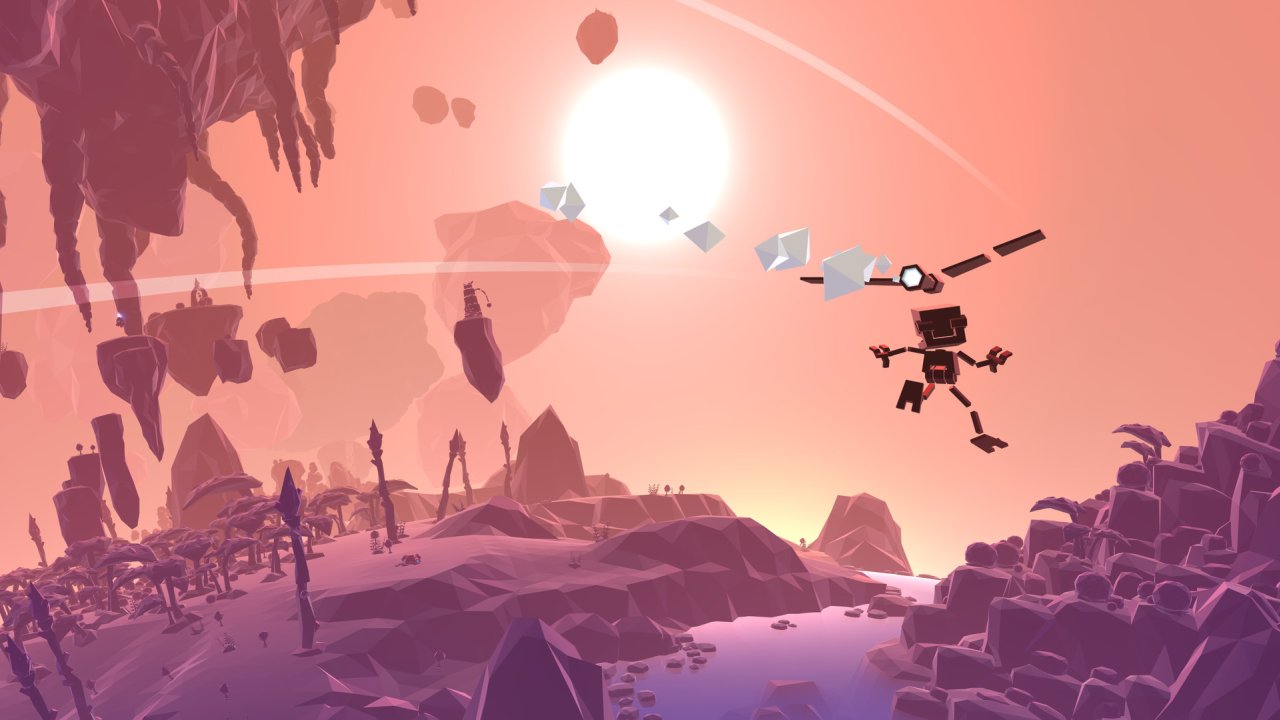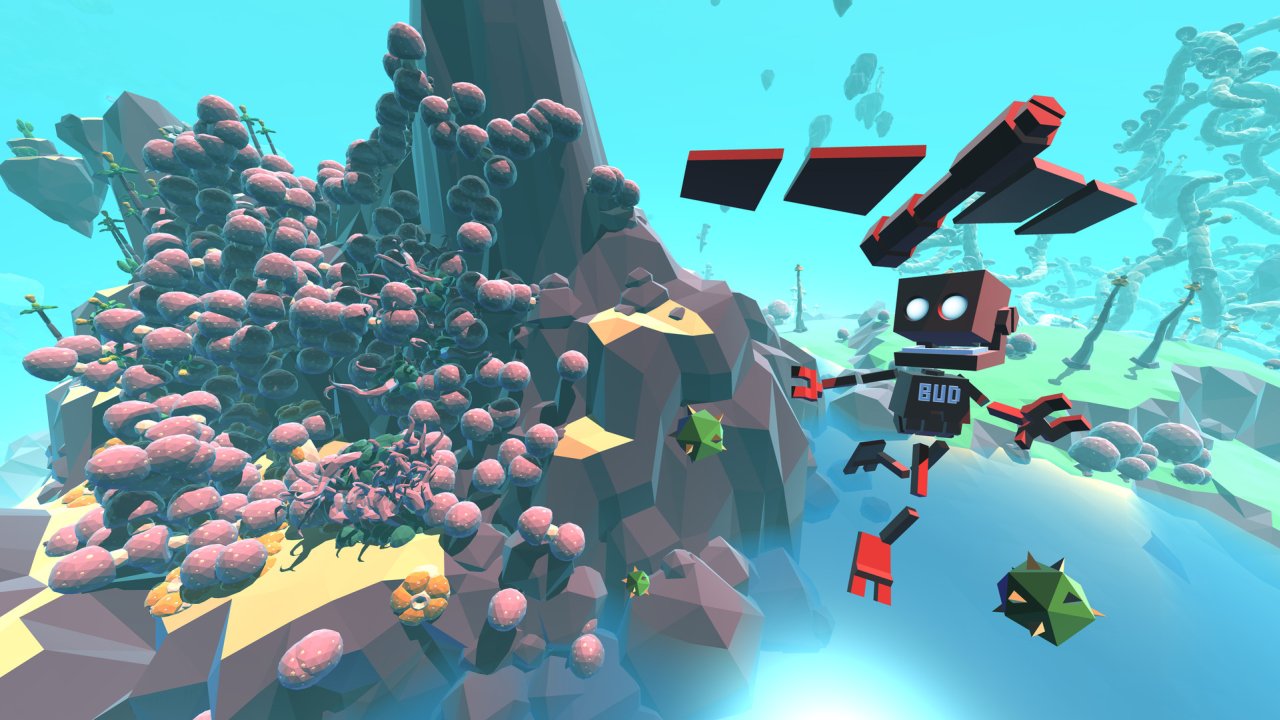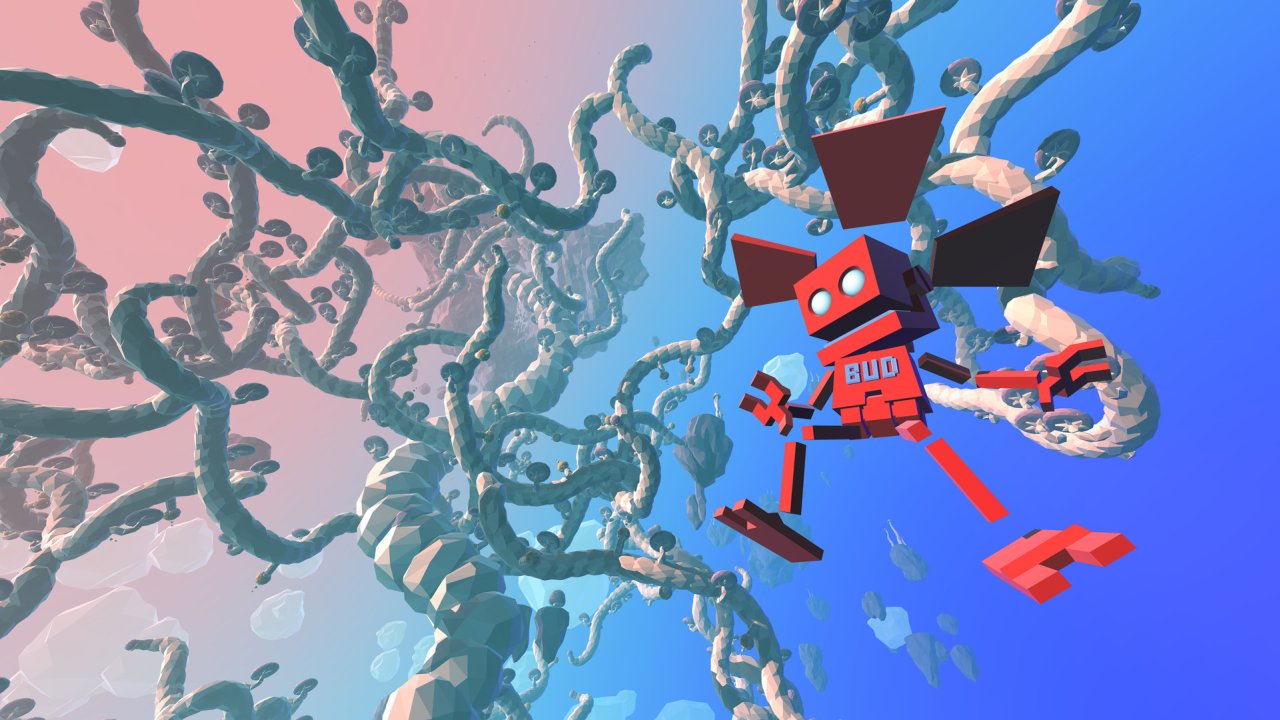Grow Up Review
In dire need of some pruning
Hey, who remembers Grow Home? I do, though that’s mostly because I still have a little trouble accepting that it wasn’t an industry-wide hallucination brought on by a Sandbox Satiation Syndrome epidemic in early 2015. Released by Ubisoft around the time Ubisoft was being peak Ubisoft, it was a charming, creative little surprise from the gargantuan megacorp that was built largely on goofy procedurally-animated climbing and a player character that was apparently held together with rubber bands and paper clips. Alright, it ultimately had you going through the same open-world scavenger hunt rigmarole that had made its peers so tiresome, but it was a step in the right direction and people applauded it, in the same way that you’d applaud a recovering alcoholic who made it all the way to lunchtime before uncorking the cheap plonk. “This is what we want,” people said. “Something fresh, inventive, small and cheap.” So Ubisoft listened, and now there’s a sequel. Warkwark.

Let’s not waste time pretending that the basic premise has evolved in any significant capacity. B.U.D reprises his role as a loose cloud of Meccano pieces with a degree in space botany, and once again he’s been dumped on an alien planet where the flora grows at the kind of reckless pace that can normally only be achieved with time-lapse photography. The keyword that distinguishes Grow Up, in this case, is simply ‘more’. Remember how your primary objective in the first game was to grow a giant vine that would corkscrew up through the heavens, unlocking new areas and prompting sniggering schoolboys to point out how much it looked like a grotesquely deformed piece of phallic imagery? Well now there are four, each with their own uniquely horrifying genital defects. One of the first things the game teaches you is how to use your map, a priority that turns out to be quite the devious piece of foreshadowing when you realize just how much is scattered across it. There’s a whole planet to explore out there now —albeit, one whose scale wouldn’t look too out of place in a lost Super Mario Galaxy sequel—full of ability pods to crack open, power crystals to harvest, ship parts to salvage, challenges to complete, and of course, plants to scan. The mild, chill scavenger hunt elements of Grow Home, left unchecked in the Ubisoft greenhouse, have spiraled out of control into an engorged tangle of sandbox collect-a-thons.
It might seem unusual to be offended at the prospect of something as innocuous as having more things to do—even coming from yours truly, an eternal font of odd gripes—but they’ve shaped the experience in such a fundamental way that it’s hard not to raise a hand in objection. Many a game has had you roaming the landscape aimlessly, homing in on collectibles to unlock some power or ability, but it’s usually as a distraction from some central objective; something you can veer off the beaten track to nab on the way to the next story mission or in the middle of a hair-raising chase. Variety is the spice of life; a game comprised entirely of distractions has no spice, only a homogeneous mashed potato slurry. One could argue that the four giant vines that litter the planet are your central objective, but they no longer dominate the landscape as they did in Grow Home, and provided that you collect enough power gems, they’re not even necessary for accessing higher ground any more; you can fly yourself to the moon and back on a rocket-powered hang-glider without needing so much as a breather. Your prime directive really is just to wander around and home in on anything that remotely stands out.
The existence of a rocket-powered hang-glider raises a few more bugbears. In spite of being packed with enough shinies to satisfy a magpie that has most assuredly gone off the deep end, the world feels a lot less dense than that of its predecessor; no longer suitably scaled for B.U.Dto simply clamber his way around. The physics-driven animation and ability to grip things with the triggers is just as much of a cute gimmick as it was in Grow Home, letting you climb, pull, uproot and occasionally hang on for dear life in an intuitive and organic way, but it hasn’t expanded one iota here. You can’t get a stronger grip or an extend-o-matic forearm; you’re doing the same left-right-left-right climbing routine, now in a world that’s far more suited to jetpacks and gliders. The mechanic that the original game was built on has been swallowed up, outmoded, and turned into a vestigial little curiosity by the landslide of new, slightly less interesting toys.

I don’t want this to become an unbroken parade of “this is different from the first game, and here’s why that’s bad”, though, so let’s look at something Grow Up adds that actually improves the experience: gardening. Yes, gardening. Simply by running your hands over its smooth, supple leaves, you can learn everything there is to know about any species of flora, and in doing so, gain the ability to plant infinite duplicates of it wherever you please. It’s pretty enticing, if you think about it: most of the plants serve some sort of practical function—usually helping you to gain altitude in some way or another—and are permanent fixtures in the environment, so it’s entirely conceivable that over the course of the game you’d slowly transform the surface of the planet, flowers and ferns springing up in your wake as you crisscross back and forth across the landscape. Unfortunately, thanks once again to the size of the world, there’s no way you’re going to have a marked effect over the course of a playthrough. You could plant things just for the heck of it, and indeed at one point I stopped mid-transcontinental-flight on a floating island to take a break and carefully lay out a meditation flower garden, but without any kind of reward feedback—or much room for creativity, for that matter—it was about as satisfying as spitting globs of chewing gum at a wall and hoping to make a smiley face.
Still, whatever damaging effects the size of the world might have on Grow Up, there’s definitely a much stronger sense of exploration now that there’s more to the environments than a narrow vertical climb. With a somewhat limited pool of assets, the planet isn’t exactly flush with recognizable landmarks—one low-poly floating island looks more or less like any other, barring changes in biome—but every now and then you’ll come across curious little anomalies that betray a special hand-crafted attention to detail; a towering stack of mushrooms, or a crescent island of waterfalls, or a bouncy flower that shoots you straight up through a hole choked with boulders into a hidden cavity, netting you a power crystal and necessitating a session at the panel beaters for B.U.D. It’s a world that looks at first almost natural enough to have been procedurally generated, but the closer you peer, the more the marks of an intelligent creator stand out. At times it even has an air of mystery to it, brought out by places and items that feel as if they ought to have a purpose but ostensibly don’t. The game establishes pretty early on that B.U.D. has the demeanor of an easily-led toddler—presumably as an explanation for why he can’t run across somebody’s front lawn without tripping and planting his gormless face in the mud—and from time to time you’ll come across his toys, scattered across the landscape with no obvious purpose. Do they do anything? Do I have to bring them somewhere? I don’t know, but Grow Up’s sudden unwillingness to acknowledge a collectible when it could be tallying them up on its completion sheet is suspicious. Suspicious, and intriguing.
If only everything you found out there in the untamed wilds was so fascinating. I have a real beef with the challenge beacons; little hovering buoys peppered around the world that charge you with travelling through a course of rings within a certain time limit. Quite apart from feeling like a rather transparent attempt to inject some form of failure state into a game where nothing short of a mid-skydive narcolepsy attack would put you in danger—I don’t know why, it’s not as if a chill exploration game like this was really crying out for some adversity—they don’t really seem particularly appropriate to the game’s upgrade structure. Mobility is pretty much the only thing that upgrades can conceivably give you, since getting from one map icon to the next is more or less the only mechanic, so a given challenge can go anywhere from ‘trivial baby time trial’ to ‘I hope you like speedrunning’ depending on whether you turned up with enough rockets strapped to your back, which hardly seems like a fair way of organizing such a self-contained activity. Even on a level playing field, though, Grow Up simply doesn’t feel cut out for time-sensitive objectives; the slippery physics-driven controls, while entertaining when you’re climbing a vine or dragging a terrified sheep around, don’t handle so well when banking between towering rock formations. Yes, of course, the challenges are entirely optional—the only rewards for completing them are cosmetic costumes, just in case you felt like showing off to that swarm of space-roaches—but then again, so’s just about everything else. If optional activities are so extraneous as to not count against the game, what are you even gauging it on? What do you want out of your purchase?

That’s not a rhetorical question, reader. What do you want out of Grow Up? Perhaps a nice, relaxing, threat-free scavenger hunt in a lo-fi open world sounds right up your alley. Perhaps you, like many other people, are drawn to the prospect of an honest timesink that doesn’t ask too much of you, to fill the catatonic purgatorial hours between the hellish corporate grindstone and the blessed release of sleep. Well slow down, friend, because even though Grow Up dreams of the stars, you may find yourself coming back down to Earth sooner than expected. Even with its scale and design philosophy, there’s a definite sunken, sallow tone to the game’s cheeks; a casual wanderer might find themselves done with it in as little as three or four hours, and while I’m sure it stretches a lot further for those willing to tick off every last box on their completion sheet, the sheer skull-scouring tedium of such a pursuit disqualifies it from being counted. I’m not normally one to complain when a game is a bit on the stumpy side—as many a reviewer has noted, it makes our jobs so much more straightforward—but when all other methods of appealing fail, the ability to keep me distracted from reality for a non-trivial fraction of 2016 is a necessary service. Grow Up doesn’t perform that, either.
Here’s the easy way to look at Grow Up: it’s a sequel. To be exact, it’s the worst kind of sequel. It had the perfect springboard to launch itself from: an experimental, original little game with some clever ideas that never reached their full potential. Grow Up is bigger, busier, and bundled with more extraneous nonsense, but the features that gave its predecessor such a promising shine—the climbing, the vine-growing, the goofy freeform physics-driven platforming—still haven’t bloomed; cast into the shade by an open world that adds very little besides a new busload of collectibles and a new environment to hunt for them in. If you missed out on Grow Home then by all means pick this up; the features that made it special are still there, albeit buried under needless mulch. If, however, you played Grow Home, and like me, saw the potential in it, then steer clear; it hasn’t grown anywhere important.
 Comments
Comments














